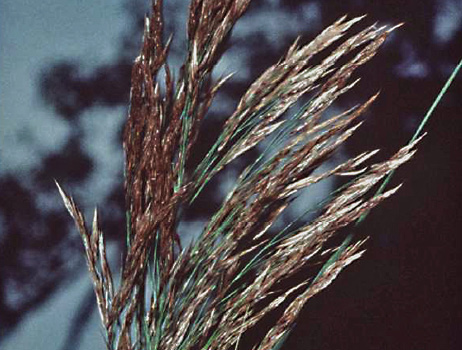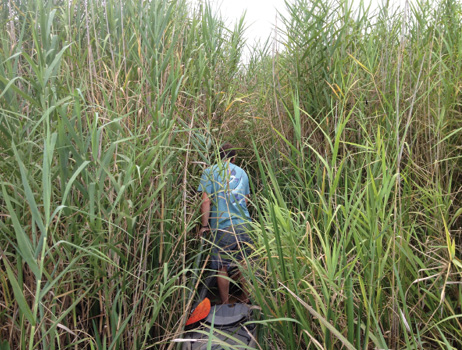Phragmites | Phragmites australis
Emergent | Native and Non-Native



Phragmites (or common reed) has native and invasive sub-species in the U.S. The invasive sub-species are most likely European in origin and exhibit aggressive growth in wetland and shoreline areas.
Common reed can reach heights exceeding 15 feet and have dozens of stems per square meter, creating a wall that prevents shoreline access, obscures views, and displaces native plant and animal species. Phragmites can grow densely, and the sharp leaves make it difficult and dangerous to walk through. It also poses a late summer and fall fire risk, as it becomes fuel for fire in its dried state.
The leaf blades of phragmites are long, flat, and between 0.4 and 1.5 inches wide. Phragmites stems are hollow and topped with a characteristic fluffy flower spike, making them easily recognizable from a distance.
Genetic studies have not identified the native species of phragmites in Mississippi ponds, suggesting only the invasive species is present in the state. If encountered, it should be eradicated immediately.
Management Value
Although some bird species use phragmites for nesting, perching, and feeding from the seeds, the negative impacts greatly outweigh any positive value. Phragmites should be eliminated on first detection.
Recommended Controls
Option 1: Imazapyr (2.0-pound formulation). For each gallon of water, mix 0.9 ounce imazapyr and 1.3 ounces non-ionic surfactant. Spray to wet all exposed plants. Do not exceed annual herbicide rate limits as stated on the product label.
Option 2: Imazamox (1.0-pound formulation). For each gallon of water, mix 2.5 ounces imazamox and 1.3 ounces non-ionic surfactant. Spray to wet all exposed plants. Do not exceed annual herbicide rate limits as stated on the product label.
Option 3: Glyphosate (5.4-pound formulation). For each gallon of water, mix 6.0 ounces glyphosate and 1.3 ounces non-ionic surfactant. Spray to wet all exposed plants. Do not exceed annual herbicide rate limits as stated on the product label.
For all options, multiple applications may be necessary to achieve eradication. The best approach is to treat plants that are actively growing.
Read and follow all chemical label instructions, especially the section on the use of personal protection equipment.
Photo Credits Top: USDA

The information given here is for educational purposes only. References to commercial products, trade names, or suppliers are made with the understanding that no endorsement is implied and that no discrimination against other products or suppliers is intended.
Publication 3735-30 (POD-11-23)
By Wes Neal, PhD, Extension/Research Professor, Wildlife, Fisheries, and Aquaculture; Dennis Riecke, Fisheries Coordinator, Mississippi Department of Wildlife, Fisheries, and Parks; and Gray Turnage, PhD, Assistant Research/Extension Professor, GeoSystems Research Institute.
The Mississippi State University Extension Service is working to ensure all web content is accessible to all users. If you need assistance accessing any of our content, please email the webteam or call 662-325-2262.



